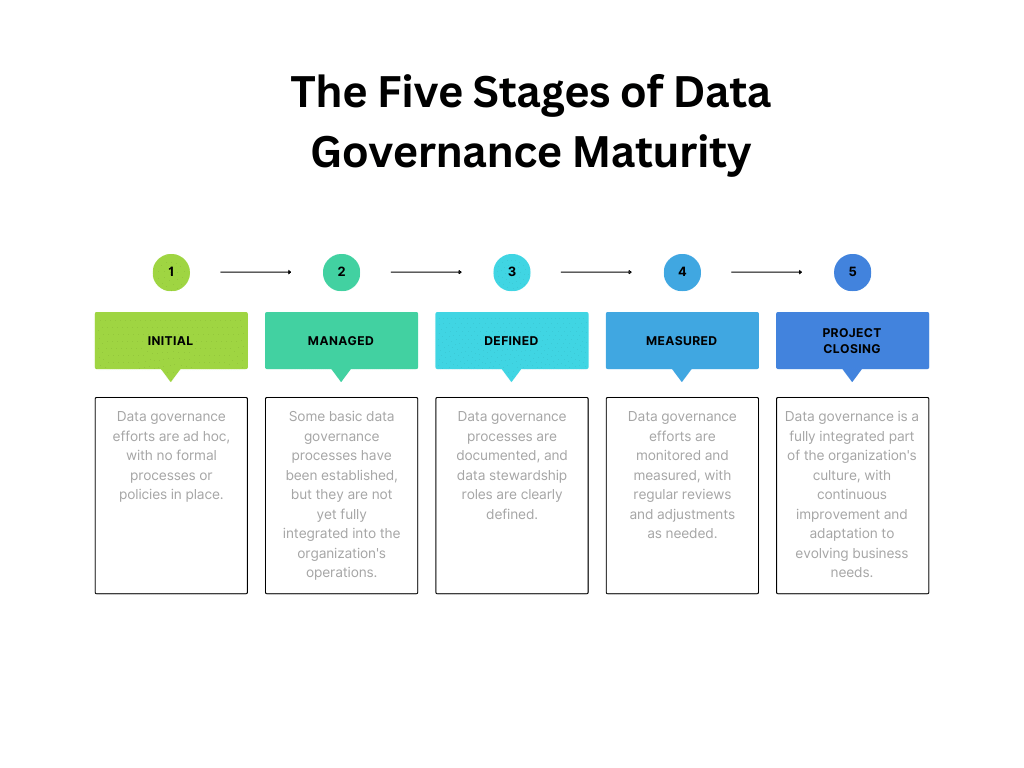- Introduction to a Data Governance Maturity Model
- The Importance of Data Governance Maturity
- The Five Stages of the Data Governance Maturity Model
- Implementing a Data Governance Maturity Model
- Step 1: Assess Your Current Data Governance Maturity
- Step 2: Set Goals and Define Success Criteria
- Step 3: Develop a Data Governance Roadmap
- Step 4: Establish Data Governance Roles and Responsibilities
- Step 5: Implement Data Governance Processes and Policies
- Step 6: Monitor and Measure Progress
- Step 7: Continuously Improve and Adapt
- Conclusion
Introduction to a Data Governance Maturity Model
Data governance maturity models and assessments measure an organization’s ability to manage and utilize its data assets effectively. As businesses increasingly rely on data for decision-making, understanding the level of data governance maturity becomes essential for success.
In this article, we’ll explore the concept of data governance maturity, discuss various maturity models, and provide actionable steps to help organizations improve their data governance practices. We’ll also include a Mermaid diagram to illustrate the stages of data governance maturity.
The Importance of Data Governance Maturity
Establishing a robust data governance program is crucial for organizations to:
- Ensure data quality and accuracy
- Facilitate compliance with data protection regulations
- Enhance data security and privacy
- Improve data-driven decision-making
By assessing data governance maturity, organizations can identify areas for improvement, set goals, and establish a roadmap for achieving a higher level of maturity.
The Five Stages of the Data Governance Maturity Model
We’ve developed a five-stage data governance maturity model to help organizations assess their current state and provide a framework for improvement. The stages are:
- Initial: Data governance efforts are ad hoc, with no formal processes or policies in place.
- Managed: Some basic data governance processes have been established but are not yet fully integrated into the organization’s operations.
- Defined: Data governance processes are documented and clearly defined data stewardship roles.
- Measured: Data governance efforts are monitored and measured, with regular reviews and adjustments as needed.
- Optimized: Data governance is a fully integrated part of the organization’s culture, continuously improving and adapting to evolving business needs.

Implementing a Data Governance Maturity Model
To successfully implement a data governance maturity model and improve your organization’s data governance practices, follow these steps:
Step 1: Assess Your Current Data Governance Maturity
Conduct a thorough assessment of your organization’s existing data governance efforts. Identify areas of strength and weakness, and determine which stage of maturity best describes your current state.
Step 2: Set Goals and Define Success Criteria
Establish clear goals for improving data governance maturity, and define success criteria for each goal. This will help ensure that your efforts are focused on achieving tangible results.
Step 3: Develop a Data Governance Roadmap
Create a roadmap outlining your organization’s steps to achieve its data governance goals. This should include specific actions, timelines, and resource allocations.
Step 4: Establish Data Governance Roles and Responsibilities
Define the roles and responsibilities of key stakeholders involved in data governance efforts. This may include data stewards, data owners, and members of a data governance committee.
Step 5: Implement Data Governance Processes and Policies
Develop and implement formal processes and policies for managing your organization’s data assets. This should include processes for data quality, data security, data privacy, and data lifecycle management.
Step 6: Monitor and Measure Progress
Regularly monitor and measure your organization’s progress toward its data governance goals. Use the success criteria defined in Step 2 to evaluate the effectiveness of your efforts, and adjust your approach as needed.
Step 7: Continuously Improve and Adapt
Data governance maturity is an ongoing journey. Continuously look for ways to improve and adapt your data governance efforts to meet the evolving needs of your organization and the broader business environment.
Conclusion
Achieving data governance maturity is essential for organizations looking to harness the power of their data assets. By following the steps outlined in this article and implementing a comprehensive data governance maturity model, organizations can improve their data management practices, enhance data quality, and drive better decision-making.
In addition to the steps outlined above, fostering a culture of data governance within your organization is important. Encourage collaboration and communication among stakeholders, and promote the value of data governance as a strategic business initiative. By doing so, you’ll be well on your way to achieving a higher level of data governance maturity and reaping the benefits that come with it.







Leave a Reply